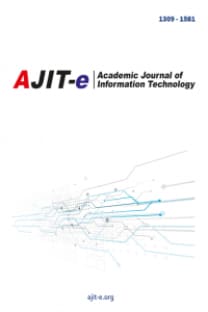Akıllı Ev Sistemleri Üzerine Bir Model Önerisi
Günümüzde, ev ve iş hayatını kolaylaştırmak amacıyla teknolojinin kullanımı daha fazla yaygınlaşmıştır. Sürekli gelişmekte ve değişmekte olan teknoloji ile birlikte de akıllı ev kavramı ortaya çıkmıştır. Uzaktan yönetim ve güvenlik çözümleri uyguladıkça evlerimiz akıllı hale gelmektedir. Akıllı hale gelen evler bize zaman, güven, hız ve konfor kazandıran yaşam alanlarıdır. Bu yoğun yaşamda evden uzakta iken enerji israfına neden olan aletlerin uzaktan kontrol edilebiliyor olması, eve girişlerin denetlenebiliyor olması kullanıcılar için daha tasarruflu, daha güvenli ve daha konforlu bir yaşam sunmaktadır. Bu çalışmada, Telegram uygulaması üzerinden gönderilen kısa bir mesajla, prototip evde bulunan AC lambalarının ve bahçe girişinde bulunan kameranın kontrolü gerçekleşmektedir. Buna ek olarak yüz tanıma sistemi ile birlikte eve giriş yapan kişinin yüzü algılanmakta ve sistem, ev sahibine giriş yapan kişinin bilgisini Telegram üzerinden bildirim olarak göndermektedir. Böylece eve girişte daha güvenli bir ortam oluşturulması amaçlanmaktadır.
A Model Suggestion on Smart Home Systems
Today, the use of technology has become more widespread in order to facilitate home and business life. With the ever-evolving and changing technology, the concept of smart home has emerged. Our homes are becoming smart as we employ remote management and security solutions. Smart homes are living spaces that give us time, confidence, speed and comfort. In this busy life, while being away from home, the devices that cause energy waste can be controlled remotely, and the entrance to the house can be controlled, providing a more economical, safer and more comfortable life for users. In this study, the control of the AC lamps in the prototype house and the camera located in the garden entrance are carried out with a short message sent via the Telegram application. In addition, the face of the person entering the house is detected with the face recognition system and the system sends the information of the person entering to the owner as a notification via Telegram. Thus, it is aimed to create a safer environment at the entrance to the house.
Keywords:
Smart Home, Telegram, Face Recognition, Remote Access / Control,
___
Ahmad, B. I., Yakubu, F., Bagiwa, M. A., & Abdullahi, U. I. (2014). Remote Home Management: An alternative for working at home while away. arXiv:1403.3274 [cs]. http://arxiv.org/abs/1403.3274Başçiftçi, F., & Gündüz, K. A. (2019). Nesnelerin İnterneti Uyumlu Mikrodenetleyiciler Üzerine Bir Araştırma. Selçuk Üniversitesi Sosyal ve Teknik Araştırmalar Dergisi, 18, 62-71.
Çilli, M. (2007). İnsan Hareketlerinin Modellenmesi ve Benzeşiminde Temel Bileşenler Analizi Yönteminin Kullanılması. (Yayınlanmamış doktora tezi). Hacettepe Üniversitesi Sağlık Bilimleri Enstitüsü, Ankara.
Gökrem, L., Bozuklu, M. (2016). Nesnelerin İnterneti: Yapılan Çalışmalar ve Ülkemizdeki Mevcut Durum. Gaziosmanpaşa Bilimsel Araştırma Dergisi, (13), 47-68. Retrieved from https://dergipark.org.tr/tr/pub/gbad/issue/29709/319647
Harper, R. (Ed.). (2003). Inside the Smart Home. Springer-Verlag. https://doi.org/10.1007/b97527
Heitmeyer, R. (2000). Biometric Identification Promises Fast and Secure Processing of Airline Passengers. ICAO Journal., 55(9).
Hyvärinen, A., Hurri, J., & Hoyer, P. O. (2009). Natural Image Statistics (C. 39). Springer London. https://doi.org/10.1007/978-1-84882-491-1
Hyvärinen, A., Karhunen, J., & Oja, E. (2001). Independent Component Analysis. John Wiley & Sons, Inc. https://doi.org/10.1002/0471221317
İlkbahar, F., & Kara, R. (2017). Performance analysis of face recognition algorithms. 2017 International Artificial Intelligence and Data Processing Symposium (IDAP), 1-5. https://doi.org/10.1109/IDAP.2017.8090338
İlkbahar, F., & Sungu, E. (2020). Analysis of artificial intelligence technologies used in the covid-19 outbreak process. International Journal of Applied Mathematics Electronics and Computers, 154-162. https://doi.org/10.18100/ijamec.800910
Jain, S., Vaibhav, A., & Goyal, L. (2014). Raspberry Pi Based Interactive Home Automation System Through E-Mail. 2014 International Conference on Reliability Optimization and Information Technology (ICROIT), 277-280. https://doi.org/10.1109/ICROIT.2014.6798330
Li Jiang, Da-You Liu, & Bo Yang. (2004). Smart home research. Proceedings of 2004 International Conference on Machine Learning and Cybernetics (IEEE Cat. No.04EX826), 2, 659-663. https://doi.org/10.1109/ICMLC.2004.1382266
Mersinoğlu, H. (2002). İletişim teknolojisi, Mimarlık Etkileşimi ve Akıllı Evler. (Yayınlanmamış yüksek lisans tezi). Yıldız Teknik Üniversitesi Fen Bilimleri Enstitüsü, İstanbul.
Mitchell, G. (2012). The Raspberry Pi Single-Board Computer Will Revolutionise Computer Science Teaching. Engineering & Technology, 7(3), 26-26. https://doi.org/10.1049/et.2012.0300
Ojala, T., Pietikäinen, M., & Harwood, D. (1996). A Comparative Study of Texture Measures with Classification Based on Featured Distributions. Pattern Recognition, 29(1), 51-59. https://doi.org/10.1016/0031-3203(95)00067-4
Ojala, T., Pietikainen, M., & Maenpaa, T. (2002). Multiresolution Gray-Scale and Rotation Invariant Texture Classification With Local Binary Patterns. IEEE Transactions on Pattern Analysis and Machine Intelligence, 24(7), 971-987. https://doi.org/10.1109/TPAMI.2002.1017623
Öztürk, A., & Naimi, S. (2017). Akilli Ev Sistemleriinde Kullanılan Yöntemlerin Farkları, Avantajları ve Dezavantajları. Istanbul Aydın Üniversitesi Dergisi, 9(4), 115-125. https://doi.org/10.17932/IAU.IAUD.13091352.2017.9/36.115-125
Stefanov, D. H., Bien, Z., & Bang, W.-C. (2004). The Smart House for Older Persons and Persons with Physical Disabilities: Structure, Technology Arrangements, and Perspectives. IEEE Transactions on Neural Systems and Rehabilitation Engineering, 12(2), 228-250. https://doi.org/10.1109/TNSRE.2004.828423
Taştan, M. (2019). Nesnelerin İnterneti Tabanlı Akıllı Sulama ve Uzaktan İzleme Sistemi. Avrupa Bilim ve Teknoloji Dergisi, 15, 229-236. https://doi.org/10.31590/ejosat.525149
Varol, A., & Cebe, B. (2011). Yüz Tanıma Algoritmaları. 5th International Computer & Instructional Technologies Symposium, Elazığ.
Yiqin, L., Fang, F., & Wei, L. (2009). Home Networking and Control Based on Upnp: An Implementation. 2009 Second International Workshop on Computer Science and Engineering, 2, 385-389. https://doi.org/10.1109/WCSE.2009.836
- Yayın Aralığı: Yılda 4 Sayı
- Yayıncı: AKADEMİK BİLİŞİM ARAŞTIRMALARI DERNEĞİ
Sayıdaki Diğer Makaleler
Merkezi Sınavlardaki Soru Kitapçıklarına A* Algoritması ile Derslerin Yerleştirilmesi
Endüstri 5.0’a Doğru: Zeki Otonom Sistemlerde Etik Ve Ahlaki Sorumluluklar
Pelin CANBAY, Zübeyde DEMİRCİOĞLU
Akıllı Ev Sistemleri Üzerine Bir Model Önerisi
Fatih İLKBAHAR, Şeyma ÜNAL, Armağan Tuğçe KARAKAYA, Bayram EREN
Duygu FINDIK COŞKUNÇAY, Şule ERDİLMEN
Bayes Ağları ile Tüp Bebek Tedavi Sürecinde Blastosist Skoru Tahmini
